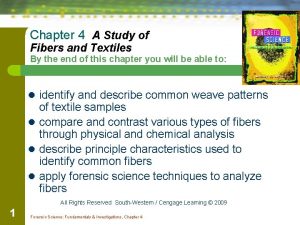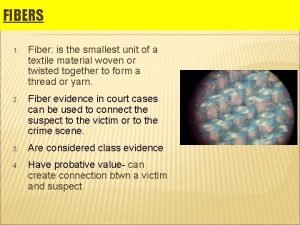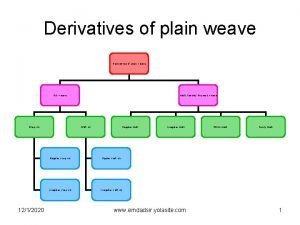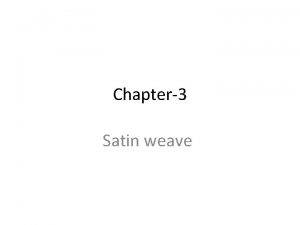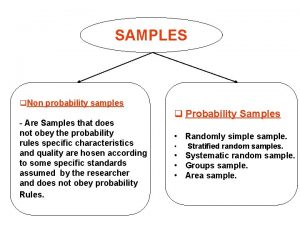11 1 Common Weave Patterns of Textile Samples













- Slides: 13

11. 1 Common Weave Patterns of Textile Samples Chapter 11: A Study of Fibers and Textiles November 30, 2014 Sanders 8: 36 PM

Fibers in Forensic Science s Fibers are class evidence. s Fibers create a link between the crime and the suspect. s As with hair, clothes shed fibers. September 3, 2021 Unit 5: The Study of Fibers and Textiles 8: 36 PM

Fibers as Trace Evidence s Fibers may be transferred directly from victim to suspect of suspect to victim. s This is known as direct transfer. s As you can see fibers are in direct contact with victim. September 3, 2021 Unit 5: The Study of Fibers and Textiles 8: 36 PM

Secondary Transfer s If a victim has fibers on his person that he picked up and then transferred to to a suspect, it is called secondary transfer. September 3, 2021 Unit 5: The Study of Fibers and Textiles 8: 36 PM

Early Collection s 95% of fibers are lost within the first 24 hours of an incident. s Collect fibers after a thorough examination. s Only collect out-of-place fibers September 3, 2021 Unit 5: The Study of Fibers and Textiles 8: 36 PM

Type of Fibers s What is the composition of the fiber? s Is it rare? s Where are the fiber found in relation to the crime scene? s What was the color? September 3, 2021 Unit 5: The Study of Fibers and Textiles 8: 36 PM

Number of Fibers Found s How many fibers found? s More fibers suggest a violent encounter. s Where were the fibers found? s If they were near or on victim’s body, you can place the victim to the scene September 3, 2021 Unit 5: The Study of Fibers and Textiles 8: 36 PM

Multiple Fiber Transfer s Are there more than one type of fibers? s Are there numerous sources? s More variety of fibers suggest longer contact or more violent contact. September 3, 2021 Unit 5: The Study of Fibers and Textiles 8: 36 PM

Type of Crime Committed s Each crime has an expected pattern of contact between s Suspect s Victim s Crime scene s This pattern is reflected in fiber transfer. September 3, 2021 Unit 5: The Study of Fibers and Textiles 8: 36 PM

Time Between Crime and Discovery of Fiber s Unless fiber location is undisturbed the value of found fiber is greatly reduced with the passage of time because fibers will be expected to fall off. September 3, 2021 Unit 5: The Study of Fibers and Textiles 8: 36 PM

Sampling Fibers s Fibers are gathered at crime scene. s Special vacuums s Sticky tape s Forceps s Important to notate and record where the fibers where gathered from. September 3, 2021 Unit 5: The Study of Fibers and Textiles 8: 36 PM

Testing Fibers s First task is to identify fiber. s Clothing s Upholstery s Carpeting s Try to match fiber to its source. September 3, 2021 Unit 5: The Study of Fibers and Textiles 8: 36 PM

Testing Fibers With a Microscope s How light behaves when interacting with fibers can help determine the fiber. s Polarizing light s Infrared light s Can determine chemical structure of fibers. September 3, 2021 Unit 5: The Study of Fibers and Textiles 8: 36 PM
 Twill weave pattern forensics
Twill weave pattern forensics Welding bead patterns
Welding bead patterns Fibers are woven into textiles or fabrics
Fibers are woven into textiles or fabrics Fibers evidence
Fibers evidence Smallest unit of fabric
Smallest unit of fabric Dating patterns since the 1960s are
Dating patterns since the 1960s are Mining frequent patterns associations and correlations
Mining frequent patterns associations and correlations Common patterns of inductive reasoning
Common patterns of inductive reasoning Highest common factor of 48 and 60
Highest common factor of 48 and 60 The gcf of 12 and 18
The gcf of 12 and 18 Common anode and common cathode
Common anode and common cathode Highest common factors and lowest common multiples
Highest common factors and lowest common multiples Prime factors of 72
Prime factors of 72 Highest common factors and lowest common multiples
Highest common factors and lowest common multiples


